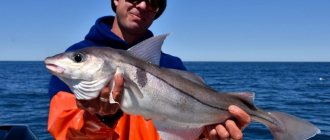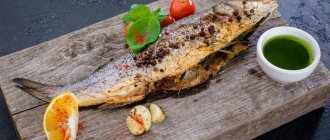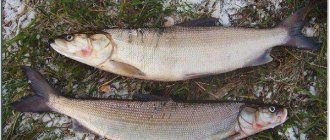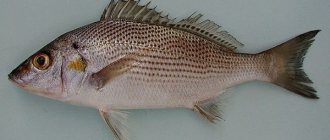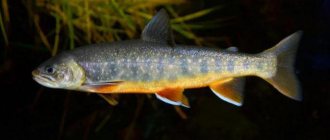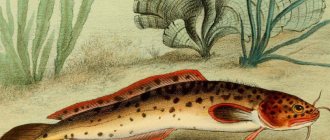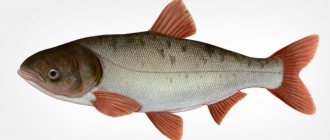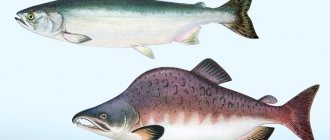Classification
Black caviar is one of the most expensive and healthy delicacies. Due to its high cost (from $50 per 50 grams), this product has always been considered a symbol of prosperity and success, associated with a luxurious, prosperous life.
Today, the main place for production of black caviar is the Caspian Sea (90% of the total volume). Limited fishing is carried out in the lower reaches of the Danube, the Amur region, and the Black Sea region.
Aquaculture caviar is obtained in two ways: conventional (the fish is caught, killed, gutted) and “non-traumatic” (sturgeon are caught, the belly is cut open, the ovaries are “milked out”, the incision is sutured, the animal is released back).
Let's consider what parameters determine the type of black caviar.
By processing and degree of maturity
- Grainy. Method of preparation: after catching the fish, raw caviar is immediately rubbed on a sieve (screen). Thanks to this procedure, the grains are cleared of veins and films, remain completely clean and intact, and retain their round shape. After punching through the screen, the product is lightly salted until the so-called “tulouse” is formed.
Properly prepared granular black caviar is called dry crumbly, in which the grains are easily separated from each other. Under-exposure in salting is not permitted; over-exposure is over-exposure.
To increase shelf life, antiseptic substances - borax and boric acid - are added to the product.
Interestingly, the lighter and larger the eggs, the more mature and tasty they are.
- Pressed. After catching the fish, the caviar is salted directly in the eggs in hot brine, after which it is laid out in splints and dried (aired). The next stage of preparation is removing the film, removing mucus and veins. At the final stage, dried (fermented) and fresh grains are crushed in vats, after which they become compacted, become flat, and acquire a piquant taste.
To transform pressed caviar into a homogeneous mass, it is salted in warm brine and lightly pressed.
- Pasteurized. Salted using the dry method. Such caviar is packaged in glass jars, which are hermetically sealed and pasteurized. The main purpose of heat treatment is to increase the shelf life of the product. This product can be stored for up to 2 years without loss of nutritional and beneficial properties. Heat treatment gives black caviar a richer taste and makes the shell of the grains tighter.
The best grainy black caviar is beluga, pressed caviar is stellate sturgeon.
By type of sturgeon fish
- Beluga. It ranks first in nutritional value and taste. This is the largest fish from the sturgeon family, reaching up to 4 meters in length and weighing up to 400 kilograms. Caviar accounts for over 25% of the total weight. Interestingly, female belugas reach sexual maturity at the age of 25 years. The lifespan of an individual is more than 100 years. Fish do not spawn every year. The ovaries are silver or dark gray in color and have a subtle nutty flavor.
Nutritional value: fats - 14.2 grams, proteins - 27.2 grams, calorie content - 237 calories per 100 grams of product.
- Sturgeon. The eggs are smaller than beluga eggs, yellowish-brown in color with a sharp tint of sea and algae. Sturgeon can weigh up to 200 kilograms and grow up to 2 meters in length. Often the weight of one adult does not exceed 80 kilograms. Sexual maturity of fish raised in warm waters occurs at the age of 9 years. Life expectancy is 80 years.
100 grams of product contains 9.7 grams of fat, 28 grams of protein, 203 calories.
In terms of cost, sturgeon caviar is inferior to beluga caviar.
- Sevruzhya. The eggs are small, black, more elastic than those of the beluga. This is the smallest sturgeon fish. Its weight does not exceed 25 kilograms, and its body length is 1.5 meters. The female stellate sturgeon spawns at 8 years of age.
The calorie content of the product is 221 calories per 100 grams, fat content is 11.9 grams, protein content is 28.4 grams. The weight of caviar accounts for 11% of the weight of the fish. It tastes best in individuals over 20 years of age.
In terms of the diameter of eggs, the laurels of superiority belong to beluga caviar (3.5 millimeters), the intermediate position is occupied by sturgeon (2.5 millimeters) and the top three is completed by stellate sturgeon (1 millimeter).
By type of packaging
- Weighed (barrel). These products are made in a handicraft way and are distributed on the market among dubious sellers. The low cost is due to improper processing, rough texture and non-compliance with the storage conditions of black caviar. In addition, for better preservation, harmful preservatives are introduced into it, enhancing the taste.
- Packaged. Caviar is packaged in tin or glass jars. This product has a pleasant consistency and high quality. It is recommended to give preference to caviar packed in glass containers, through which you can visually inspect the product.
BY PACKING TYPE
Weighed (barrel)
These products are made in a handicraft way and are distributed on the market among dubious sellers. The low cost is due to improper processing, rough texture and non-compliance with the storage conditions of black caviar. In addition, for better preservation, harmful preservatives are introduced into it, enhancing the taste.
Packaged

Caviar is packaged in tin or glass jars. This product has a pleasant consistency and high quality. It is recommended to give preference to caviar packed in glass containers, through which you can visually inspect the product.
What's the benefit?
Black caviar is a unique product containing a lot of vitamins (A, B1, B2, B6, B9, B12, C, E, D, choline) and minerals (iron, magnesium, calcium, phosphorus).

The rich chemical composition determines the beneficial properties of the product:
- supports the immune system, visual acuity;
- normalizes the condition of the nervous system and joints;
- increases sexual desire;
- relieves anemia;
- improves mental activity, sugar metabolism;
- removes toxins;
- keeps the body in good shape;
- stimulates the functioning of internal organs;
- neutralizes the harmful effects of free radicals;
- accelerates tissue regeneration;
- strengthens bones;
- improves the condition of patients suffering from coronary heart disease;
- prevents stroke, myocardial infarction, anemia;
- increases mental capacity;
- gives elasticity to blood vessels;
- activates the production of collagen in the layers of the skin.
Black caviar has restorative, anti-inflammatory, rejuvenating and anti-allergic properties. In terms of nutritional value, the product is healthier than meat.
Interestingly, elite cosmetics based on “black gold” prolong the youth of aging skin (after 35 years), maintain hair thickness, and give natural shine to hair. Due to the high cost of cosmetics created on the basis of a protein product, they are produced in limited quantities only by name brands. These include: “La Prairie” (Switzerland), “Ingrid Millet” (France), “Penovia Botanica” (USA), “Diademin” (Germany), “Mirra Lux” (Russia).
Varieties of black caviar according to cooking methods
Different types of processing are used:
- Granular is prepared from eggs of equal size, from raw materials of excellent quality. This is a very expensive delicacy. It is salted with a preservative and, if necessary, pasteurized.
- Pasteurized caviar is subjected to heat treatment. The price is a little cheaper than the grain one. With this method, freshness is preserved longer.
- To prepare pressed caviar, the product is placed in a hot salt solution. After heat treatment, the eggs are placed under a press to remove excess moisture.
- Yastichnaya is caviar salted together with yastyk. That is, the grain is not separated from the connective tissue. The yastyki are pre-cut into 10 cm pieces. They are prepared by strong salting in brine. There are two varieties depending on the strength of salting. A tasty and nutritious product that tolerates storage well. Previously in Rus' there was a known method of preparing black caviar to order. This is a ternary caviar. After rubbing the grains through a sieve, the product was poured with warm, vigorous brine, waiting for it to drain. Then the caviar was packaged in pound barrels.
Varieties
The division into varieties depends on the method of processing and taste:
- “Standard” has the most affordable price. This is a pasteurized product and does not smell fishy. Safe for baby food.
- “Premium” is a product of the highest quality that has undergone pasteurization. It is obtained from older fish.
- “Classic” - a preservative is added for preservation.
- “Premier” is prepared by salting the eggs of females aged 10-15 years.
- “Imperial” - caviar is collected from sturgeon over fifteen years of age. The most expensive variety with a special taste: oily, thick, rich, with a bitter taste.
Imitated caviar
This is a high-quality fake of a natural one. It is harmless provided that no synthetic dyes were used in production. Externally it is quite attractive and affordable. Soviet scientists worked on creating an imitation of caviar in the seventies of the last century, so that a healthy protein product would appear on the table of all Soviet people. In the beginning it was made from real protein, including chicken eggs and vegetable oil. That’s what it was called: “protein”. The taste was a little like the natural one. Now the product is made using a different technology, based on extracts of brown and red algae with the addition of gelling agents. They call it imitated.
Price range
This year, this delicacy is presented in Russian stores in a large assortment. In the Russian Federation, the price of this product on the consumer market depends on the variety.
The most expensive is beluga. The cost ranges from ten to twenty thousand rubles per 100g, up to 150 thousand per kilogram. They receive little of it, since most beluga individuals have been destroyed. In aquaculture, it takes 15 years for a reared female to begin producing eggs.
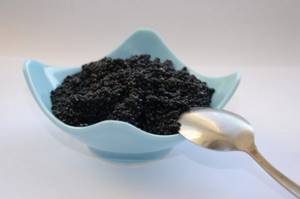
Sturgeon is more affordable in price, which is why the product is popular. In Moscow it sells for 45 - 50 thousand rubles per 1 kg.
Sterlet is offered from 40 thousand per kilogram, a jar weighing 50 g costs two and a half thousand.
Black caviar in duty free 1 kg at a price of 100,000 rubles. Grown in aquaculture they sell from 35,000 to 50,000 rubles. Astrakhan 1 kilogram from 25,000 to 30,000 rubles. Albino beluga caviar sells for $34,500, although it is very rare on sale.
How to choose the right one
A lot of black caviar is sold in Russia, taken by poachers in places located at the mouths of rivers flowing into the Caspian Sea. Although its price is lower than the official one, it is better to refrain from purchasing it. If you consume poached products, you will end up in the hospital with serious poisoning.
Preference should be given to the product in glass jars. It is more convenient to view the contents in them. You can be sure that there is no unpleasant metallic taste in the caviar. In an open jar we will see a white coating on top of the caviar, like frost. To determine whether we purchased a real product or a fake, you can put a few eggs in a small amount of boiling water. If the eggs have dissolved, you have a fake in front of you. Artificial caviar has a distinctly uniform color.
Which caviar is healthier: red or black?
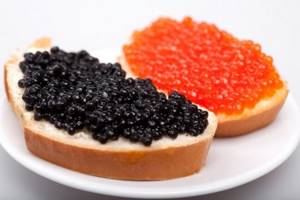
First of all, it is worth noting that both products are considered royal delicacies and are a natural storehouse of protein, omega-3, omega-6 acids, vitamins and minerals. It is naive to believe that different types of sturgeon caviar (sturgeon, beluga, stellate sturgeon) and salmon (salmon, chinook salmon, pink salmon, chum salmon, sockeye salmon) are the same. The color, taste, and shape of the grains depend on the fish from which they are obtained.
There is a misconception that black caviar is healthier than red caviar. These products have approximately the same nutritional value. The high cost of black caviar is due to the rarity of the delicacy. Sturgeon fish species lay offspring in “adult” age (not earlier than 10–15 years) only 1–2 times in their entire life (in 100 years). Extracting black caviar is not an easy task, which only skilled fishermen can do. It is obtained in much smaller quantities than the red one, which is not difficult to catch if you know the “bread” places.
Individuals of the salmon family become sexually mature at 2–5 years of age. They spawn in fresh water bodies. Most migratory salmon spawn only once in their lives, after which they die immediately. Some individuals (for example, salmon) spawn up to 4 times in their lives.
Thus, both products are equally beneficial for human health and are recommended for use by all people over 3 years of age who are not allergic to the product.
What is the most valuable caviar?
In the fish world, there is a cult of respect for age: the older the female, the more valued her caviar is. With age, any seasoned sturgeon fish, regardless of breed, begins to spawn larger, lighter and more delicate caviar, the price of which increases proportionally. But the fish is not put on the counter along with the caviar, so we will determine the value differently.
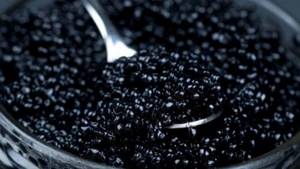
The most expensive caviar in the world is called Almaz. This exclusive product is produced by belugas from that part of the Caspian Sea, which, to our chagrin, belongs to Iran.
Only the caviar of fish whose age has exceeded 80 years can be called “diamond”. Diamond eggs are large, light golden, almost white, they have a velvety-silky surface, and the taste is considered simply breathtaking - with pronounced nutty and creamy notes.
Such caviar is packaged in jars made of 24-karat gold, and the price per kilogram starts at $25,000 and can reach up to $40,000, depending on the “yield” of the year.
Harm
The main disadvantage of black caviar is its high salt content, which causes problems with blood pressure and swelling. This product is contraindicated for children under 3 years of age, people with high blood cholesterol, atherosclerosis, problems with the digestive system, and urolithiasis.
Another important disadvantage of the product is that it is not environmentally friendly. In recent years, the sturgeon population has been rapidly declining, which threatens the state of their gene pool. In this regard, the delicacy is obtained at fish farms, where individuals are raised under artificial conditions for the food industry.

It is strictly prohibited to catch sturgeon in the wild in unlimited quantities, as this threatens the biodiversity of our planet.
What does black caviar taste like?
The range of flavors of caviar is very wide: from seaweed to dried fruits. Which black caviar is better - everyone decides for himself: in its taste you can find salty, iodine, creamy-buttery and even sweetish nuances. Each species of sturgeon produces caviar with its own special taste. Beluga, a rare fish of enormous size, has caviar with an unusually delicate, unctuous flavor texture and a very long aftertaste. And it doesn’t go well with most white wines - too direct and bright the taste of the wine will most likely overwhelm the subtlety of the caviar. But exquisite champagne and vodka go perfectly with beluga caviar.
Chemical composition
100 grams of “black gold” contain from 200 to 250 calories.
Currently, there is an opinion that the product of sturgeon fish is the main enemy of the figure, as it leads to obesity.
Actually this is not true. Caviar is a valuable nutritious product, which contains essential amino acids, vitamins, macro- and microelements, polyunsaturated triglycerides such as omega-3, omega-6. The product consists of 50% water, 30% proteins, 13% fatty acids, 5% inorganic substances, 2% nutrients. Table No. 1 “Comparative characteristics of black caviar by sturgeon species”
| Components | Contents per 100 grams of product | ||
| Beluga, granular | Sturgeon, grainy | Stellate sturgeon, grainy | |
| Energy value | 237 calories | 203 calories | 221calories |
| Water | 54.2 grams | 56.5 grams | 54.0 grams |
| Squirrels | 27.2 grams | 28.0 grams | 28.4 grams |
| Fats | 14.2 grams | 9.7 grams | 11.9 grams |
| Ash | 4.4 grams | 5.2 grams | 5.4 grams |
| Saturated fatty acids | 2.5 grams | 1.7 grams | 2.1 grams |
| Carbohydrates | 0.8 grams | 0.6 grams | 0.7 grams |
| Cholesterol | 0.36 grams | 0.3 grams | 0.33 grams |
Table No. 2 “Chemical composition of black caviar by sturgeon species”
| Name | Nutrient content per 100 grams of product, milligrams | ||||
| Beluga, granular | Sturgeon, grainy | Stellate sturgeon, grainy | |||
| Vitamins | |||||
| Tocopherol (E) | 4,0 | 3,2 | 3,5 | ||
| Ascorbic acid (C) | 1,8 | 1,7 | 2,0 | ||
| Niacin (PP) | 0,9 | 1,5 | 1,5 | ||
| Retinol (A) | 0,55 | 0,18 | 0,1 | ||
| Pyridoxine (B6) | 0,46 | 0,29 | 0,26 | ||
| Riboflavin (B2) | 0,4 | 0,36 | 0,37 | ||
| Thiamine (B1) | 0,12 | 0,3 | 0,28 | ||
| Folic acid (B9) | 0,051 | 0,024 | 0,024 | ||
| Cholecalciferol (D) | 0,008 | 0,008 | – | ||
| Macronutrients | |||||
| Sodium | 1630 | 1620 | 1699 | ||
| Phosphorus | 465 | 460 | 470 | ||
| Potassium | 80 | 70 | 80 | ||
| Calcium | 55 | 40 | 60 | ||
| Magnesium | 37 | 35 | 45 | ||
| Microelements | |||||
| Iron | 2,4 | 2,2 | 2,5 | ||
Black caviar is considered perfectly balanced. It is prescribed to seriously ill people to increase hemoglobin, speed up recovery, strengthen the immune system and “return” vitality. The product is needed by children and adolescents for normal development.
To preserve the beneficial properties of black caviar, during the production process it is flavored with a small amount of salt, which should not exceed 5% of the weight of the main component.
Sturgeon grains are very capricious. To ensure that the consistency of the eggs does not change and the taste does not deteriorate, they are stored at a temperature of 2 to 4 degrees below zero.
List of fish with black caviar
This delicacy is obtained from fish from the sturgeon family. It has inhabited our planet for more than 250 million years, outliving mammoths and dinosaurs. However, people are making great efforts to destroy this valuable population. The black caviar market is 90% poached. For the sake of small eggs, poachers mercilessly destroy huge females that have grown for decades before their last spawning.
The most valuable commercial species from the sturgeon family are the following: sturgeon, beluga, stellate sturgeon, thorn, sterlet.
Sturgeon are 19 species found in the marine waters of the northern hemisphere, Europe and North America. They go to fresh rivers to spawn. A Caspian sturgeon travels to the mighty Russian Volga River. But some prefer to spawn on the Terek, Samura and Ural rivers. The Volga female sturgeon, depending on size and age, lays from one hundred thousand to a million eggs. Having finished spawning, they leave for the vastness of the oceans. Black caviar contains many useful microelements, the entire range of amino acids, and many vitamins.

Beluga is the largest freshwater fish. In the sturgeon family it looks like a king. She is a long-liver; a hundred years is not the limit for her. The size is simply enormous, as it is a seasoned predator. Those that live in the Caspian basin even eat the calves of Caspian seals. Their gluttony can only be satisfied by the vast expanses of the sea. But beluga spawning occurs exclusively in fresh water. To do this, females, when it’s time to reproduce, rush upstream. Some of them do this already at the end of January and remain in the river waters until June, when they spawn. The autumn race begins to ascend the river in August and sometimes remains for the winter in deep river pools. There are records of the maximum sizes of these fish ever caught by fishermen. In 1827, a beluga 9 meters long and weighing one and a half tons was caught in the Volga. In 1922, an individual was caught in the Caspian Sea that weighed more than 1,200 kilograms and contained 146 and a half kilograms of caviar. Giant females can lay more than two hundred kilograms of black caviar. For them, the issue of finding a place for spawning is fundamental. Ichthyologists have established that if she does not find a secluded place for eggs suitable in the opinion of the future mother, then she will not spawn and the eggs will gradually dissolve in her womb.
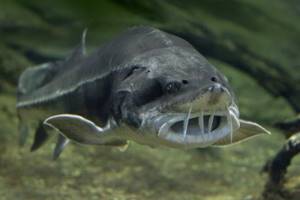
Stellate sturgeon is not that big, up to 80 kg and a little more than two meters. But her eggs are quite large and have a regular granular shape. Now almost extinct, its numbers are controlled by the International Union for Conservation of Nature. It is still found in the basins of the Azov, Caspian, and Black Seas. It sails to the Volga, Ural and Kura rivers to spawn. Partially goes to the Danube. Sevruga needs high-speed currents and a clean bottom covered with gravel. If the flow rate decreases after spawning, the embryos may die. According to information from the Red Book, the stellate sturgeon is endangered due to poaching, water pollution, blocking and destruction of watercourses in spawning areas. In 1990, more than fifty thousand dead sturgeon were found in the Sea of Azov, having died in polluted water.
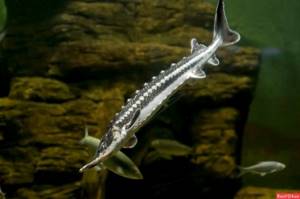
Now it is bred at the sturgeon fish hatchery in Temryuk and the Khillinsky fish hatchery.
On holiday tables this fish is a real star. It is generally called the star sturgeon because of the characteristic bony plates on the body. The Latin name stellatus means "covered with stars." It also has a long, dagger-like nose.
The thorn is unknown to the mass consumer; it is prohibited to extract it in natural habitats. This is an inhabitant of the Black and Caspian seas, sometimes visiting the Volga and Ural. Weight up to 30 kg, length up to 2 meters.
With the beginning of the drying up of the Aral Sea, the thorn disappeared there, as the flow of the Amu Darya and Syr Darya rivers stopped. From the Caspian Sea it goes to spawn in the Kura River, in the Iranian part - to Sefidrud. Currently found in the Danube and Rioni, which belong to the Black Sea basin.
In nature, the thorn forms a cross with beluga or stellate sturgeon (called “stellate thorn”). On the Kura there are viable hybrids called “thorn - sturgeon” and “thorn - stellate sturgeon”. They are obtained through artificial insemination. In some places in the wild it is caught by local fishermen, but the export of caviar is prohibited. It is grown in commercial fish factories in Russia, Iran, and Kazakhstan. Juveniles are sometimes released into the Kuban and Don rivers. Back in the 30s of the last century, it was considered a commercial fish, and since 1983 it has been included in the Red Books of Kazakhstan and Uzbekistan.
The thorn does not spawn every year, and the young often die in the mouths of predatory fish. After birth, she lives in fresh water for about a year, after which she goes to sea. Few make it.
The whole fish is delicious, not just its black caviar. The head of the thorn produces a rich, bright orange soup that is very aromatic. There are almost no carbohydrates in the carcass, only easily digestible protein and fish oil, so it is very useful for people with gastrointestinal diseases.
Sterlet is a delicacy fish, very tasty. Weight is about 15 kg, length 120 cm. Its caviar is not of a grainy consistency, but sticky, but also tasty and healthy. She lays a litter every year, starting at the age of seven. The sterlet reaches puberty earlier than other sturgeons. Found mostly in fresh water. These are rivers that replenish the basins of the Azov, Black, Baltic and Caspian seas. It is mined in the Don, Volga, Kuban. Nowadays, a hybrid of sterlet and beluga called bester is grown for industrial fishing. He gains weight quickly and doesn’t get sick much. Gives more caviar.
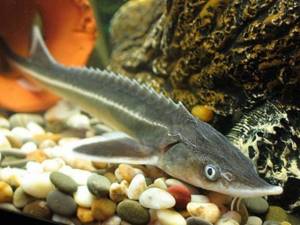
Criterias of choice
Black caviar is an expensive product that is often counterfeited by unscrupulous manufacturers. As a base, schemers use pike grains, which are very similar in taste to sturgeon and beluga.
In the fake delicacy, all the eggs are the same size and go one after another. But in the present, on the contrary, they are different, since there are no ideal forms in nature.
The grains of a good high-quality product are clear, glossy, and have a fresh, buttery taste, in which notes of salty sea water are clearly visible.
What should you pay attention to?
- Price. The fair price for 50 grams of black caviar varies from $50 to $120 depending on the variety and type of sturgeon. Pressed milk is packaged in specially sealed packages or large jars, the weight of which is 120 grams. The price of this product starts from $120. If the product costs much less, rest assured that this is a fake.
- Manufacturer. For many years, black caviar was mined only in the Caspian Sea. Over 15 years, the number of sturgeon fish has decreased by 38.5 times. Today, in order to avoid extinction of the species, they are grown in artificial farms - in aquaculture enterprises. Under these conditions, thanks to modern technologies, eggs are obtained in a gentle way, after which the females do not die, but continue their life cycle.
According to expert data, as of 2009, 20 tons of food sturgeon caviar were produced from aquaculture in European countries. At the same time, the leading positions are occupied by: Moldova (300 kilograms), Romania (500 kilograms), Bulgaria (5 tons), Russia (12 tons).
Large aquaculture enterprises: Beluga, Raskat (Astrakhan), Caviar Court food processing (Saudi Arabia), Karat Kavyar (Israel), Aquatir (Moldova), Qinjiang, Shandong, "Heilongjiang" (China).
Currently, illegal production of sturgeon waste products is widespread, which puts a heavy burden on the ecosystem of the globe. According to statistics from Russian law enforcement agencies, the state’s domestic market is 90% poached.
Interestingly, in order to restore the sturgeon population, commercial fishing in the Caspian Sea is prohibited until 2021.
- Container, accompanying documents. Black caviar is packaged in glass and tin jars. In the first case, packaging allows the buyer to visually inspect the product for color and grain size. The shelf life of pasteurized caviar in glass jars does not exceed 24 years, pressed caviar – 9 months.
To check the quality of a product packaged in a tin can, shake the container: if you hear gurgling, it means the product contains a large amount of liquid, which reduces the specific gravity of the delicacy. Avoid purchasing such a product.
Remember, a quality product is always certified. A conscientious manufacturer provides accompanying documents stating that the caviar was obtained legally, has a CITES permit, and is obtained from sturgeon that is grown in aquaculture.
- Appearance. Depending on the maturity of the caviar, its color varies from gray-brown to silver-black, and the grain size from small to large. Also, pay attention to the quality of the product. The grains must not be the same size, whole, and not crushed. The most valuable product is the one with light, large eggs.
- Taste and smell. High-quality black caviar emits a faint marine aroma that can only be detected by a person with a keen sense of smell. A sharp, strong smell of fish is a sign of a spoiled product or a fake.
Real black caviar has a delicate, lightly salted taste with creamy and nutty notes. If after tasting you feel sour, excessive saltiness or bitterness, you should avoid consuming the product. Most likely it is damaged. Remember, salt retains moisture, which leads to increased weight of the delicacy. Unscrupulous sellers take advantage of this. This product does not resemble caviar, but rather a sticky mass with a sharp, specific odor.
In order not to spoil the taste of the noble delicacy, it is served in glass, porcelain vases or small caviar bowls placed in a bowl filled with crushed ice. The dish is served with a silver, bone or mother-of-pearl spoon, excluding contact with base metals. They worsen the taste of black caviar.
How to choose and store correctly
In order to choose the right caviar, you need to pay attention to the following parameters:
- the price cannot be cheap - granular caviar costs from 2000 rubles per 50 g, while pressed caviar is slightly cheaper and is packaged in larger jars - from 5000 rubles per 150 g;
- On the shelves in 2021, caviar from the Astrakhan fish farms “Beluga” and “Raskat” is more often found; Vologda "Fish House"; and from the fishery in Volgorechensk;
- when stored closed in a glass jar, caviar retains all its basic properties for 2 years;
- if the jar is opened, then its contents must be sold within 2-3 days;
- all products must be accompanied by a certificate of quality (conformity);
- in the case of a tin jar, it must be shaken before purchasing - the caviar should not “lobble” - this is the first sign of a low-quality product;
- if you can see the color of caviar through the container, it is worth remembering that the lighter grain is of particular value - gray-brown, silver-black - this is the color of the best caviar;
- the taste is very delicate, with a slightly nutty aftertaste, without pronounced bitterness;
- caviar that is too salty, bitter, with a distinct fishy taste may be a sign of a fake.
Another subtle point in the absorption of this delicacy is the method of serving. According to Russian tradition, they are served in a glass bowl or vase, and from there they are portioned into small plates.
According to the European version of serving, it is served in portioned caviar bowls set on crushed ice to keep it chilled for as long as possible.
In both the first and second cases, it must be remembered that caviar can only be taken with a mother-of-pearl or porcelain spoon. Metal contact with caviar is undesirable.
What are the benefits of black caviar?
It has long been considered one of the most nutritious and balanced foods. Caviar contains almost all the substances necessary for the development of the human body. This is a general tonic that has a positive effect on brain function, improves blood circulation and reduces the risk of blood clots. Caviar is useful for atherosclerosis and urolithiasis. The product improves memory, increases hemoglobin, and stimulates the removal of excess fluid from the body.
For women
The composition of sturgeon eggs is highly valued by cosmetics manufacturers. The delicacy improves complexion, stimulates regenerative processes, accelerates wound healing, makes the skin more elastic, fights signs of aging and gives a healthy appearance. Caviar is actively used by such well-known brands:
- Diademin;
- Ingrid millet;
- La Prairie;
- Mirra Lux;
- Ash;
- Penovia botanica.
A very useful delicacy for pregnant women. Omega-3 and omega-6 support the body. While pregnant, women often experience iron deficiency anemia and calcium deficiency, so doctors recommend including caviar in your diet. The product increases hemoglobin, lowers blood pressure and cholesterol levels, and reduces swelling. The magnesium it contains helps with cramps, and folic acid stabilizes bleeding and stimulates the normal development of the baby’s tissues and organs.
For men
The delicacy contains a large amount of arginine, an amino acid that has a positive effect on male potency. Its constant use can rejuvenate and make the body healthier. Caviar should be included in the daily diet of men who work physically and have problems with the digestive system.
- Appendicitis: where is the appendix located in humans?
- Inflammation of the parotid, submandibular and sublingual salivary glands
- Omez - instructions for use and analogues
For children
Real black caviar can be given to children from the age of three. The product is necessary for the growing body as a source of vitamins and minerals. Calcium promotes the normal development of the child's bones, and magnesium prevents the occurrence of seizures. Thanks to ascorbic acid, the product improves immunity and has a positive effect on children's vision. The delicacy improves mental activity, which is especially useful for young schoolchildren.
What is black caviar
Eggs are eggs that develop in the ovaries of fish. They are covered with a dense shell and contain a lot of yolk mass. Unfertilized eggs are used as a food product. Fish with black caviar are representatives of the sturgeon family (beluga, sturgeon, stellate sturgeon, thorn).
The delicacy is consumed salted as an appetizer served with chilled drinks (champagne, vodka, dry white and rose wines). Pairs well with butter, sour cream, soft white cheese, pancakes, and boiled eggs. Successfully complements the taste of baked or fried vegetables. The eggs are also placed on toast, unleavened dough baskets or cucumber slices.
Varieties
Fish delicacy is:
- lightly salted (in tin or glass jars);
- strong salting (in barrels).
In terms of price, the most expensive is beluga caviar, the cheapest is sterlet.
Beneficial features
The beneficial properties of black caviar are due to its low calorie content (264 kcal per 100 g), high content of macro- and microelements, vitamins, and valuable protein components. The eggs contain 30% protein, up to 28% fat (mainly omega-3), and about 3% carbohydrates. The benefits of black caviar for pregnant women are explained by the high content of substances necessary for embryonic development.
A complex of essential nutrients was found in the fish delicacy, and the percentage content in 100 g of product for some of them exceeds the daily requirement of the human body.
Vitamins:
- thiamine - 0.19 mcg (12.7%);
- vitamin A - 271 mcg (30.1%);
- riboflavin - 1.8 mcg (34.4%);
- vitamin B4 - 490.9 mcg (98.2%);
- pantothenic acid - 3.5 mcg (70%);
- pyridoxine - 0.32 mcg (16%);
- folates - 50 mcg (12.5%);
- cobalamin - 20 mcg (667%);
- calciferol - 2.9 mcg (29%);
- alpha tocopherol - 1.89 mcg (12.6%).
Macro- and microelements:
- potassium - 181 mcg (7.2%);
- calcium - 275 mcg (27.5%);
- magnesium - 300 mcg (75%);
- sodium - 1500 mcg (115%);
- phosphorus - 356 mcg (44.5%);
- iron - 11.88 mcg (66%);
- manganese - 0.05 mcg (2.5%);
- copper - 110 mcg (11%);
- selenium - 65.5 mcg (119%);
- zinc - 0.95 mcg (7.9%).
This composition has a beneficial effect on human health:
- normalizes blood composition, reduces thrombus formation;
- supports the functions of the immune, endocrine and reproductive systems;
- improves the appearance of skin, hair and nails;
- prevents the development of diseases of the cardiovascular system;
- reduces the risk of malignant tumors;
- improves twilight vision by supporting the synthesis of visual pigments in the retina.
Black caviar is useful for pregnant and lactating women in small quantities (up to 50 g per day). Excessive indulgence in it can lead to allergies, high blood pressure, dry mouth, thirst, swelling and calcium deficiency (due to excess sodium). The salty product is not recommended for people with chronic renal failure and children under 3 years of age.
Black caviar: facts and history
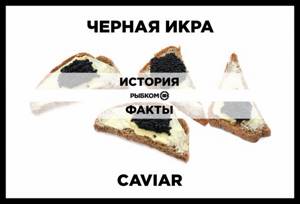
is the common name for sturgeon caviar. Traditional black caviar comes from sturgeon, beluga, stellate sturgeon and thorn. Black caviar contains a full range of amino acids, including glutamic and aspartic, lysine, serine, leucine; minerals: potassium, magnesium, phosphorus and iron, as well as many vitamins.
It's no secret that today black caviar is a real delicacy, not only because of its price, but also because this product is limited in quantity. It takes a long time to wait for an individual to reach sexual maturity and the first eggs - from 5 (sterlet) to 20 (beluga) years. At the same time, sturgeon fish species are listed in the Red Book of the Russian Federation and therefore amateur fishermen cannot obtain sturgeon with caviar on their own. The exception is paid fishing ponds, where sturgeon are bred specifically for catching.
A little history
The southern Russian word “caviar”, denoting pressed (pressed) or grain caviar, like the European name “caviar”, comes from the Turkish “havyar”, which translates as “caviar”.
The first mention of black caviar in historical sources occurs in the third century BC. e. in the writings of Diphilus of Sifnos. In the Greek Empire, caviar was actively imported from the Black Sea regions for the residents of Alexandria. After the decline of the ancient empires, caviar in the West disappeared from tables, remaining a popular delicacy only in the territory of Byzantium, which is confirmed by trade registers of the 11th century and Greek poems of the 12th century, in which there is a mention of “an exquisite dish called caviar or kabiari, which is prepared in Constantinople near Black Sea".
In the 17th and 18th centuries, caviar again fell out of European fashion, but the Italians continued to spend considerable effort and money importing it from Alexandria and Russia. Moreover, the volume of production and demand was so great that, as Narius reported in 1627, “the Russians make caviar right on the Black Sea coast and immediately send it to Italy.” In those days, caviar was stored in cloth bags that were buried on the shores of the Caspian Sea and the caviar was perfectly preserved due to the large amount of borax in the soil. In addition, there is information that by the end of the 17th century, Italian merchant ships sailed to the Baltic Sea to take on board cargo of caviar. In 1741, Savary wrote about Kavia in his Dictiannaire du commerce: “We are just beginning to become acquainted with this bolus in France, where it is not refused even at the best tables.”
Types of caviar
There are three main types of black caviar based on the breeding fish: beluga, sturgeon and stellate sturgeon; the largest and most valuable is beluga caviar.
Caviar produced in aquaculture farms is also divided into milk and cut (more expensive), depending on the method of its production from fish.
Fish farmers distinguish six stages of egg maturity. Usually, the granular eggs go through the fourth stage, the third stage goes into the pressed stage, and the second stage goes into the ovary stage. In fish farms, maturity is determined by selecting small portions of eggs with a special probe.
Black caviar, according to production methods, is divided into granular canned, granular barreled, pressed and poached.
Granular caviar cannot be pasteurized. Consists of whole, undeformed grains, easily separated from one another. Based on salting and packaging, granular caviar is divided into lightly salted in jars and heavily salted in barrels.
Pressed caviar is prepared by salting in a heated saturated salt solution with constant stirring and subsequent pressing of the grain.
Yastik caviar is prepared from yastyk eggs without separating the grain from the connective tissue, by strong salting in brine. Yastik is pre-cut into pieces 10-12 cm long. Yastik is a thin but durable film that forms a shell bag containing caviar of salmon and sturgeon. Caviar is not classified by type of fish. It is produced in two varieties, differing in salinity.
Previously, ternary caviar was known, made to order. They rubbed it through a sieve in the same way as grainy brine, doused it sharply with warm, strong brine and let it drain, achieving dehydration. Then they were packed into pood-sized barrels and sent by postal troika to Moscow.
Mining locations
The main place of production of black caviar (90% of world production) until the beginning of the 2000s was the Caspian Sea. Over 15 years (from 1991 to 2005), the sturgeon population in the Caspian Sea decreased by 38.5 times; Due to a sharp decline in the number of sturgeon, from 2021 all Caspian countries have adopted an international moratorium (ban) on fishing for all species of sturgeon in the Caspian Sea. Mining was also carried out in the Sea of Azov, the Black Sea region, and the lower reaches of the Danube. In China, licensed fishing is carried out in Heilongjiang province, on whose territory the Amur River flows.
Despite the fact that black caviar is considered to be a symbol and one of the main assets of Russia, according to Wikipedia, since 2015, the world's largest producer and exporter of black caviar is China, the second place was occupied by the United States, and the third by Iran.
Nevertheless, for Russians the Astrakhan region has been and remains the homeland of black caviar.
Taste and quality of caviar
Let's focus on Astrakhan black caviar.
As @a_ikra.ru writes on her Instagram, the unique taste of Astrakhan black caviar has only three simple components: winter + water of the Volga delta + unique food supply of the Caspian Sea.
“In the warm season, the fish feed actively.
The food supply of the Caspian Sea allows it to quickly recover after winter, and most importantly, directly affects the taste of future caviar. The key factor here is the diversity of the food supply: zooplankton, krill, amphipods, sprat, etc. With the onset of cold weather (water temperature below 5 degrees), the fish here are “hibernating”.
She barely moves and doesn't eat. This means that when spring comes, she goes hungry to spawn. The fish “rises” from the sea into the river, then spawns and then “rolls” back into the sea to feed. Due to the fact that the sturgeon “rises” into the river against the current, all its waste products, which could negatively affect the taste of the caviar, are washed away. In the end, all that is most valuable remains and not an ounce of extra. It is this unique combination of factors that has provided the unique taste of Astrakhan black caviar for many years. ⠀ Well, since Astrakhan has always been a fish region, where they knew “how to properly salt caviar,” the popularization of caviar as a delicacy also began from here. From the fishing settlements of the Volga delta: Ikryanoye, Marfino, etc.,” reports @a_ikra.ru
Sounds nice, doesn't it?
But is this really so? To answer this question, our Editorial team contacted Yaroslav Viktorov, a representative, as well as the All-Russian Research Institute of Fisheries and Oceanography (VNIRO) to clarify what exactly affects the taste of caviar.
“Previously, when fishing for “wild” fish and caviar was allowed, the quality was primarily influenced by the skills of specialists. In fish that go against the current to spawn, the eggs mature. The fish had to be removed from the river in time, at a time when its eggs were ripe, but had not begun to flow. At this stage, the caviar is maximally ripe and has the most valuable properties. Then skillfully transport the caviar to the place of selection, observing temperature conditions, etc. And, of course, the preparation technologies are the same caviar makers. Here are the main aspects. Well, the ecology (clean water, food supply) also of course influences,” Alexey Smorodov, Head of the VNIRO Public Relations Department
However, it is important to understand that at the moment, due to the ban on industrial and recreational sturgeon fishing, all caviar is aquaculture. Therefore, the variety of taste of caviar directly depends on the producers who grow and feed the fish.
“The fish are in the most natural environment for themselves - in cages in the Volga delta. Sturgeon does not grow in ponds with stagnant water, but constantly resists the flow. In order to obtain caviar that is as close in taste as possible to the taste of wild fish, we raise the fish in its historical homeland and feed it with food items familiar to it, as far as possible. The most important rule is the breadth of the diet. 90% of what the fish would eat in the wild, it receives in the form of food, so the taste of the caviar is as close as possible to the taste of wild fish caviar,” says Yaroslav Viktorov, representative.
These facts are confirmed by the Head of the VNIRO Public Relations Department, Alexey Smorodov:
“The differences in black caviar from different fish farmers depend on many factors - cultivation technology, feed, water treatment, temperature conditions, etc. The genetics of those sturgeons that are bred for taste and color also play a big role...”
Read about the nuances of choosing black caviar in stores and its real cost in our article “Black caviar: how much it can cost and how to choose a delicious one.”Source: ru.wikipedia.org
Illustration: Miroslavik from Pixabay

